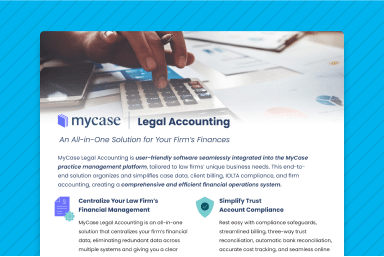Trust Accounting Made Easy For Your Firm

Now that’s quite a lofty title, right? Isn’t trust accounting supposed to be complex? Isn’t it the infamous process that trips up attorneys and bookkeepers new to legal accounting?
While I’m here to tell you that it can be simple when done correctly, it literally all comes down to following the rules.
Fortunately, the folks at MyCase shared this great resource, which provides information on all the different states’ bar rules. Make this your first stop, especially if you are a cloud-based accountant or bookkeeper. Every state has different rules, and some states even have rules that are further segmented by county. Hence, you need to dig deep to understand what is expected of the attorney and the law firm.
Basics of trust accounting

Trust accounting must be done right, even at its most simplistic level. While you may understand that the funds that law firms receive are prepayments (also called retainers), it’s just as essential to understand attorneys’ language when working with legal clients.
Since these prepayments are not the law firm’s money, you must comply with the state bar rules. Mismanagement of trust account funds can result in fines or, in the most severe case, an attorney can lose their license to practice law. Hence, managing these funds is so critical.
The best way to monitor trust accounts is to have complete visibility in the records. Since the receipt of trust funds or a retainer is a liability, you can break it down into straightforward entries:
- Debit the trust bank account
- Credit the trust liability account
Depending on the software used, it can be placed into one trust liability account and tracked by the customer name or any other preferred method. For example, if you create sub-ledger accounts in your accounting sofware and track individual client registers using these accounts, the log would look like this:

Depending on the law firm and the local bar rules, sometimes attorneys use the funds directly out of the client’s trust bank account to pay for client expenses. Other times, they use their operating funds and bill that back at the time of invoicing when the revenue is earned. That’s for the money in.
The transaction will look like this if client fees are paid out of the trust bank account.
You would write a check out of the trust bank account and book it into the client sub-ledger. That would result in a decrease in the retainer funds or the upfront deposit.
- Debit the sub-liability account or ledger for the client or your parent account using the customer method
- Credit the trust bank account
If the expense for the client is paid from the operating account, that’s a different story. The funds are booked into the advanced client cost account for the debit, and the credit would be to the operating bank account.
The law firm’s client is typically invoiced either monthly or twice a month. Billing schedules depend on the firm and the practice area. If client expenses and fees are paid out of the operating bank account, they are billed back to the client during invoicing. Those expenses are added to any time the attorney has tracked.
The three-way bank reconciliation

Another essential compliance step when working with attorneys is the three-way bank reconciliation. The three ways are:
- The bank statement ending balance plus or minus any in-transit transactions
- The balance in the trust bank account, which is reconciled to the bank statement
- The total balance of all of the individual trust ledgers for the balance of the parent account trust ledger if you use the customer method
When using the customer method, you must know what is in the total sum of the parent account. In other words, the Bar Association wants to see that you know to the penny what is in each individual account that totals the entire balance of the trust bank account. Remember that client funds held in the retainer accounts are not the law firm’s money; it belongs to its clients. I cannot emphasize that enough when working with attorneys and trust accounts.
Legal Tech Software
I would be remiss writing an article on trust accounting without mentioning legal software. Software like MyCase Accounting will assist you in tracking these trust matters and clients. Additionally, the software helps ensure you don’t overstate or send back more money than the client initially gave you. We never want to see negative trust liabilities. The software makes easy and quick work of tracking trust matters. If you use QuickBooks as a stand-alone product (without legal software), it can be done, but there’s much work around skin manual processes that make this an inefficient choice when working with attorneys. The small investment in the software will pay itself back in dividends with time savings and accuracy.
I hope you enjoyed this article. It’s a topic we are passionate about at our firm. It has to match to the penny. Yes, I said penny. There is no adjusting away any amounts of money because you can’t balance it.


